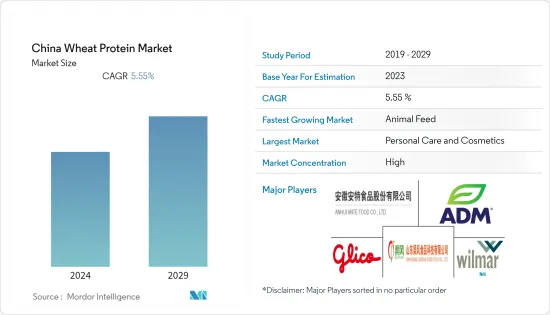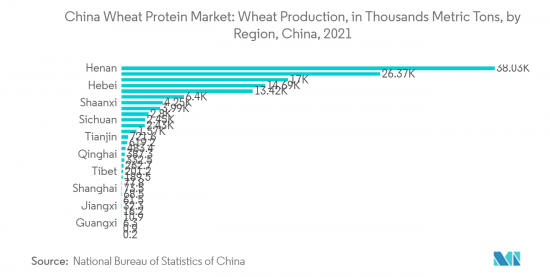PUBLISHER: Mordor Intelligence | PRODUCT CODE: 1406962

PUBLISHER: Mordor Intelligence | PRODUCT CODE: 1406962
China Wheat Protein - Market Share Analysis, Industry Trends & Statistics, Growth Forecasts 2024 - 2029

The China wheat protein market size is expected to grow from USD 130.88 million in 2024 to USD 171.52 million by 2029, at a CAGR of 5.55% during the forecast period (2024-2029).
Key Highlights
- The middle class has been boosted in China as the economy has developed, which has caused changes in dietary preferences. Protein-rich foods are becoming increasingly popular among consumers, and wheat-based products, which frequently contain protein, have grown in popularity. In the food and beverages segment, meat & meat alternatives and bakery are the fastest-growing sub-segments, driven by increasing consumption of these products enriched with wheat protein. This indicated the increasing demand for wheat protein as a key ingredient in the food and beverages segment in China.
- Further, to meet shifting consumer demands, China's food industry has started launching new innovative wheat-based products. This includes creating specialty wheat-based components for diverse food uses, such as wheat protein isolates. The demand for wheat protein has also increased as interest in functional foods and plant-based diets has grown. In addition to other vegan or vegetarian products, wheat protein is frequently used as an ingredient in plant-based meat substitutes. Thus, all the above-mentioned factors positively drive the wheat protein market in China.
China Wheat Protein Market Trends
Animal Feed, Food and Beverages Industry holds the Largest Segment by End User
- In the Chinese market, wheat protein was majorly accepted for use in the animal feed segment, followed by the food and beverages segment, in undefined. In the food and beverages sector, this protein has immense applications in bakery foods, RTE foods, and breakfast cereals due to its functionalities and protein fortification.
- Functionalities of wheat protein, such as providing the binding required for the pellet or granule forms of feed and water insolubility that decreases pellet breakdown, are driving its applications in the animal feed segment, making it one of the most preferred segments for wheat protein usage.
- The market is further growing with the innovative strategic moves of local and regional players in the country, increasing product availability and trust among consumers. Additionally, gluten sensitivity or intolerance is an issue for a significant population in China, while many others can safely consume wheat protein. Some people have severe allergies to other common protein sources like soy or almonds, which has led to a preference for wheat-based substitutes in some products. Hence driving the need for wheat protein as a functional food ingredient for the F&B industry.

Wheat Protein Concentrates Holds a Significant Share.
- Concentrates (especially wheat gluten) are leading the market. The wheat protein concentrate is obtained from gluten. Their water absorption and structure-building properties make them preferable for various applications.
- The continuously rising production of wheat protein concentrates (WPC) with non-genetically modified organisms (GMOs), organic, and clean-label claims for natural products is projected to drive the segment. For instance, according to the UN Comtrade Statistics, China's gluten import value accounted for USD 2.43 million in 2021, while its import value in 2021 accounted for USD 2.01 million, indicating its significant demand.
- Further, the food and beverages sector's dominance is led by the increased use of wheat protein concentrate due to its functions, including strength, flexibility, remarkable efficiency, and high protein content. Moreover, WPC can be used as a meat extender or replacer in meat products like sausages, patties, and meatballs to increase protein content while supplying texture and binding qualities. Additionally, it aids in lowering the total amount of fat in meat products. Hence, wheat protein concentrate drives the Wheat protein market in China.
China Wheat Protein Industry Overview
The China wheat protein market is fragmented and has a large number of small-scale players. Significant major players are embarking on strategies, such as product innovation, expansion, and acquisition, as there is a small room for growth in the near future. Major players have a notable amount of investment to push the market forward. The market leaders focus on launching innovative, low-calorie, protein-rich, and natural ingredient-based protein powders. Huge investments have been made in R&D to develop products for specific needs.
Thus, the opportunities lie in for the manufacturers to innovate in technological advancements under the natural category. Further, the major players are expanding their production capacities and strategically planning to supplement their export facilities in order to stand out among other manufacturers in the market. Moreover, these players merge with local players to gain dominance in the local markets. The major players in this market are Anhui Ante Food Co. Ltd, Archer Daniels Midland Company, Ezaki Glico Co. Ltd, Shandong Qufeng Food Technology Co. Ltd, and Wilmar International Ltd (sorted alphabetically).
Additional Benefits:
- The market estimate (ME) sheet in Excel format
- 3 months of analyst support
TABLE OF CONTENTS
1 INTRODUCTION
- 1.1 Study Assumptions and Market Definition
- 1.2 Scope of the Study
2 RESEARCH METHODOLOGY
3 EXECUTIVE SUMMARY
4 MARKET DYNAMICS
- 4.1 Market Drivers
- 4.1.1 Rising Product Innovation in Meat Alternatives Drive the Wheat Protein Market
- 4.1.2 Increasing Demand for Plant Protein in Food and Beverages Segment
- 4.2 Market Restraints
- 4.2.1 Increasing Gluten Intolerance Population
- 4.3 Porters Five Forces Analysis
- 4.3.1 Threat of New Entrants
- 4.3.2 Bargaining Power of Buyers/Consumers
- 4.3.3 Bargaining Power of Suppliers
- 4.3.4 Threat of Substitute Products
- 4.3.5 Intensity of Competitive Rivalry
5 MARKET SEGMENTATION
- 5.1 Form
- 5.1.1 Concentrates
- 5.1.2 Isolates
- 5.1.3 Textured/Hydrolyzed
- 5.2 End-user
- 5.2.1 Animal Feed
- 5.2.2 Personal Care and Cosmetics
- 5.2.3 Food and Beverages
- 5.2.3.1 Bakery
- 5.2.3.2 Breakfast Cereals
- 5.2.3.3 Condiments/Sauces
- 5.2.3.4 Meat/Poultry/Seafood and Meat Alternative Products
- 5.2.3.5 RTE/RTC Food Products
- 5.2.3.6 Snacks
6 COMPETITIVE LANDSCAPE
- 6.1 Most Adopted Strategies
- 6.2 Market Share Analysis
- 6.3 Company Profiles
- 6.3.1 Anhui Ante Food Co. Ltd
- 6.3.2 Archer Daniels Midland Company
- 6.3.3 Cargill Incorporated
- 6.3.4 Ezaki Glico Co. Ltd
- 6.3.5 Roquette Freres
- 6.3.6 Shandong Qufeng Food Technology Co. Ltd
- 6.3.7 Tereos SCA
- 6.3.8 Wilmar International Ltd
- 6.3.9 the Sudzucker Group (Beneo GmbH)
- 6.3.10 Lantmannen
7 MARKET OPPORTUNITIES AND FUTURE TRENDS




